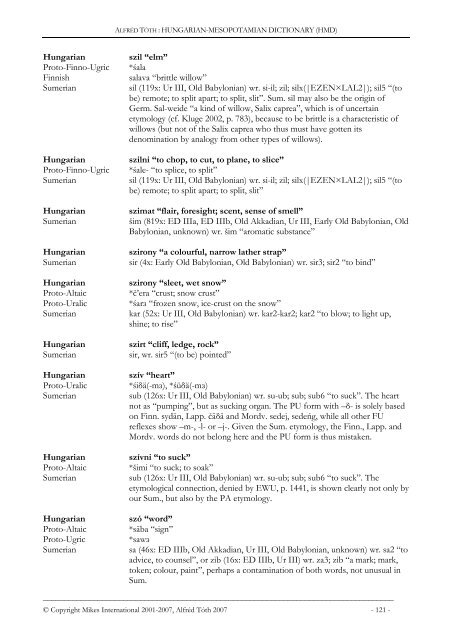Hungarian-Mesopotamian Dictionary (HMD)
Hungarian-Mesopotamian Dictionary (HMD)
Hungarian-Mesopotamian Dictionary (HMD)
Create successful ePaper yourself
Turn your PDF publications into a flip-book with our unique Google optimized e-Paper software.
ALFRÉD TÓTH : HUNGARIAN-MESOPOTAMIAN DICTIONARY (<strong>HMD</strong>)<br />
<strong>Hungarian</strong><br />
Proto-Finno-Ugric<br />
Finnish<br />
Sumerian<br />
<strong>Hungarian</strong><br />
Proto-Finno-Ugric<br />
Sumerian<br />
<strong>Hungarian</strong><br />
Sumerian<br />
<strong>Hungarian</strong><br />
Sumerian<br />
<strong>Hungarian</strong><br />
Proto-Altaic<br />
Proto-Uralic<br />
Sumerian<br />
<strong>Hungarian</strong><br />
Sumerian<br />
<strong>Hungarian</strong><br />
Proto-Uralic<br />
Sumerian<br />
<strong>Hungarian</strong><br />
Proto-Altaic<br />
Sumerian<br />
<strong>Hungarian</strong><br />
Proto-Altaic<br />
Proto-Ugric<br />
Sumerian<br />
szil “elm”<br />
*śala<br />
salava “brittle willow”<br />
sil (119x: Ur III, Old Babylonian) wr. si-il; zil; silx(|EZEN×LAL2|); sil5 “(to<br />
be) remote; to split apart; to split, slit”. Sum. sil may also be the origin of<br />
Germ. Sal-weide “a kind of willow, Salix caprea”, which is of uncertain<br />
etymology (cf. Kluge 2002, p. 783), because to be brittle is a characteristic of<br />
willows (but not of the Salix caprea who thus must have gotten its<br />
denomination by analogy from other types of willows).<br />
szilni “to chop, to cut, to plane, to slice”<br />
*śale- “to splice, to split”<br />
sil (119x: Ur III, Old Babylonian) wr. si-il; zil; silx(|EZEN×LAL2|); sil5 “(to<br />
be) remote; to split apart; to split, slit”<br />
szimat “flair, foresight; scent, sense of smell”<br />
šim (819x: ED IIIa, ED IIIb, Old Akkadian, Ur III, Early Old Babylonian, Old<br />
Babylonian, unknown) wr. šim “aromatic substance”<br />
szirony “a colourful, narrow lather strap”<br />
sir (4x: Early Old Babylonian, Old Babylonian) wr. sir3; sir2 “to bind”<br />
szirony “sleet, wet snow”<br />
*č’era “crust; snow crust”<br />
*śarз “frozen snow, ice-crust on the snow”<br />
kar (52x: Ur III, Old Babylonian) wr. kar2-kar2; kar2 “to blow; to light up,<br />
shine; to rise”<br />
szirt “cliff, ledge, rock”<br />
sir, wr. sir5 “(to be) pointed”<br />
szív “heart”<br />
*śiδä(-mз), *śüδä(-mз)<br />
sub (126x: Ur III, Old Babylonian) wr. su-ub; sub; sub6 “to suck”. The heart<br />
not as “pumping”, but as sucking organ. The PU form with –δ- is solely based<br />
on Finn. sydän, Lapp. čāδâ and Mordv. sedej, sedeńg, while all other FU<br />
reflexes show –m-, -l- or –j-. Given the Sum. etymology, the Finn., Lapp. and<br />
Mordv. words do not belong here and the PU form is thus mistaken.<br />
szívni “to suck”<br />
*šimi “to suck; to soak”<br />
sub (126x: Ur III, Old Babylonian) wr. su-ub; sub; sub6 “to suck”. The<br />
etymological connection, denied by EWU, p. 1441, is shown clearly not only by<br />
our Sum., but also by the PA etymology.<br />
szó “word”<br />
*sāba “sign”<br />
*sawз<br />
sa (46x: ED IIIb, Old Akkadian, Ur III, Old Babylonian, unknown) wr. sa2 “to<br />
advice, to counsel”, or zib (16x: ED IIIb, Ur III) wr. za3; zib “a mark; mark,<br />
token; colour, paint”, perhaps a contamination of both words, not unusual in<br />
Sum.<br />
___________________________________________________________________________________<br />
© Copyright Mikes International 2001-2007, Alfréd Tóth 2007 - 121 -








![Letöltés egy fájlban [4.3 MB - PDF]](https://img.yumpu.com/50159926/1/180x260/letaltacs-egy-fajlban-43-mb-pdf.jpg?quality=85)








